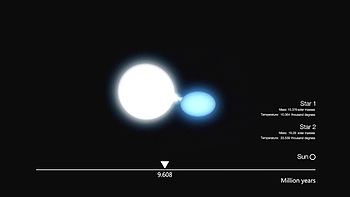EVOLUTION OF DOUBLE STARS

Anıl ATALAN - Istanbul University, Institute of Science, Department of Astronomy and Space Sciences, Istanbul
Introduction
The evolution of a star is generally explained in terms of the radius of the star or the radiant power. During the evolution of the star shows wrestling and departure lines. For this reason, mass and chemical composition should be known. However, in the evolution of near double systems, the sum of the mass of the sum of the atoms, the mass ratio and the orbital period are very important. For this reason, the three components constantly change.
The most important physical property of stars. Particularly overlapping binary stars allow geometric details to be determined. The effect of the second star can cause the star to deform. This effect can not be observed easily in double stars, but it can change the decay acceleration and the orbit. Other indications that allow the star structure to deteriorate; substance transfer, axis rotation and reflection effect.
It began in 1941 by Otto STRUVE to suggest that there might be a gas flow between the components to explain the characteristic behavior of β Lyrae at the time of retention. The same thought made sense by observing the same thing as the stars. Unlike a star alone, it acts like a system transfer to binary stars. It can be seen that evolution can accelerate.
It is about merging that affecting them when looking at the evolution of single stars. It depends on its evolution processes and this population is regulated. In binary systems, however, the expansion of the main star is blocked due to the comrade's effectiveness. For this reason, it transfers some of the large diameter star surface to the companion star. This transfer is the reason for bringing the flood in the big star Roche lobe.
Roche will unite in two stars. It is similar. Gem systems potentially switch to another drag. Roche keeps evolving them in the lobby. They can adjust according to mass changes.
Mass Transfer
Enumerative factor causing mass transfer is loss of angular momentum. This can be by gravitational radiation and magnetic braking.
Gravitational radiation is called a wave that is outward as a result of regularly twisting the space while twin stars revolve around each other. It is very difficult to determine these waves because they love energy. For this reason, gravitational radiation produces little mass transfer.
Magnetic braking creates a star polygon that fills the Roche lobe and causes these winds to drop their momentum by throwing away the substance. Magnetic field lines cause the material to be turned into stars. However, this wind provides a transfer of very little mass. However, it is more effective than gravitational radiation.
RESULT
A mass augmented asterisks as a combination of mass transfer. However, for a situation arising from being a dual system, the expansion is limited and controlled. It could turn into a neutron star. After that, the star that increases another mass continues the evolution of the normal order.
Resources
'The Evolution of Binary Systems', Philipp Podsiadlowski
'Single and Double Star Evolution', Icko Iben, Jr.
'ONE AND TWO STAR STRUCTURES AND EVOLUTION', Ed: C.W.H. de Loore and C. Doom Kluwer, 1992
Congratulations @anilatalan! You have completed some achievement on Steemit and have been rewarded with new badge(s) :
Click on any badge to view your own Board of Honor on SteemitBoard.
For more information about SteemitBoard, click here
If you no longer want to receive notifications, reply to this comment with the word
STOP